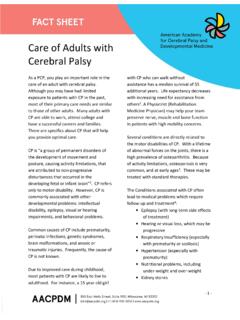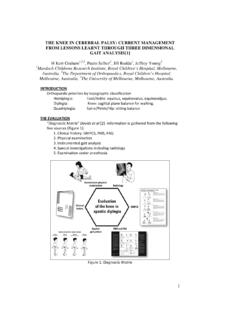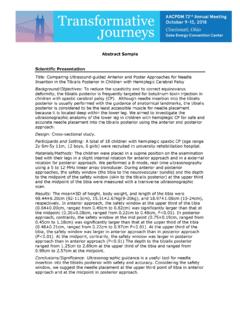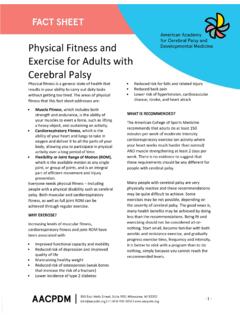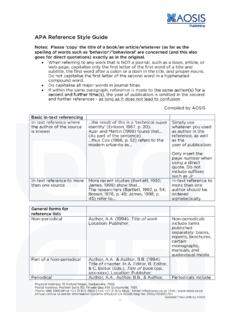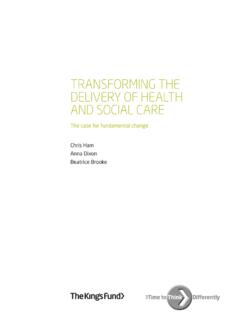Transcription of Neuropharmacologic Agents for Agitation after Traumatic ...
1 Neuropharmacologic Agents for Agitation after Traumatic Brain Injury Disclosures Most, it not all, of the medications discussed have not been tested in pediatric populations. Most, if not all, the medications discussed are being used off-label in pediatric populations. No financial disclosures Agitation after TBI: Impact Adults 3x more likely in first 6 months after head injury to show aggression than those with multiple Traumatic injuries without head injury 25% of adults showed aggressive behavior 60. months after discharge from inpatient rehabilitation unit for TBI. 70% of adults during inpatient TBI rehabilitation experience Agitation Agitation has been shown to negatively affect rate of recovery in acute inpatient rehabilitation Agitation after TBI.
2 Symptoms: Physical and verbal aggression Explosive anger Akathisia Irritability Mood lability Maladaptive behavior Disorientation Management of Post-TBI Agitation Identify and address possible cause/contributors including: Sleep disruption / alteration of sleep wake cycle Sources for discomfort Lines/catheters Unidentified injury (fracture, etc). Inadequate pain control Gastrointestinal distress (reflux, constipation, ileus). Seizures subclinical epilepsy can present as intermittent aggression Disorientation, post- Traumatic amnesia Neuroendocrine dysfunction Post- Traumatic hydrocephalus Drug withdrawal (pain medications, other meds from ICU).
3 Polypharmacy Pharmacologic Management: Measure Intervention Response Identify symptom that causes disruption: Aggression Dis-inhibition Akathisia Disorientation Acquired mood disorder (depression/anxiety). Mood lability Monitor frequency of disruptive behavior/symptom through close observation Monitor frequency of activity disruption Use outcome measures .. Agitated Behavior Scale (ABS). Non-Pharmacological Management of Post-TBI Agitation Environmental Controls Reduce Noise (turn off TV, monitors if possible). Reduce interruptions (minimize and cluster vitals/med administration/nursing care). Limit number of visitors at a time Allow for down-time for patient Reduce contributors to Agitation Orientation/Memory strategies Identify and treat pain Eliminate unnecessary medications Behavioral management Coordinated program to address specific behaviors Incorporate entire care team (family members, psychology, nursing, therapists).
4 Pediatric Research on Pharmacologic management of Agitation after TBI. Extremely Limited 1 prospective study Few case series/reports Adult Research on Pharmacologic management of Agitation after TBI. Cochrane review last updated 2008. 6 studies met criteria (RCT's) for meta-analysis Propranolol (2). Pindolol (2). Methylphenidate (1). Amantadine (1). Research supports use of -Blockers Effect seen within 2-6 weeks Response similar in both subacute and chronic timeframe Benzodiazepines Work on GABA molecule to create: Anxiolytic, sedative, antispasticity, anticonvulsant and AMNESTIC effects Effect duration varies based on medication Short (1-8 hour half life) midazolam, alprazolam Intermediate (8-40 hour half life) lorazepam Long (>40 hours) Diazepam, clonazepam Benzodiazepines Benzodiazepines: Side Effects Side effects include the following.
5 Amnesia/memory loss Increased daytime fatigue Decreased concentration Decreased alertness TBI causes the above effects as well Repeated use of benzodiazepines may slow/impair neuronal recovery after focal injury Benzodiazepines: Research Pediatric Research: None Benzodiazepines: Take Home Points Use of benzodiazepines is discouraged due to side effects confounding and even delaying recovery after brain injury Limited use on an as needed basis may be appropriate -Blockers Proposed mechanism of reducing hyperadrenergic activity Commonly used for periodic autonomic instability and dystonia (Storming). In retrospective studies shown to improve survival when used acutely after ABI.
6 Current prospective placebo study looking at effect of adrenergic blockade acutely after brain injury on survival and functional outcomes (clonidine and propranolol). -Blockers: Side Effects Bradycardia Orthostatic Hypotension Fatigue Sedation -Blockers: Research Pediatric Research: None Adult Research: 2 randomized placebo-controlled trials (Brooke 1992, Greendyke 1986) show benefit with propranolol for Agitation in the weeks after injury (Brooke) and for aggressive behavior months and years after injury (Greendyke). -Blockers: Take Home Points Research supports use in adults for Agitation Reduces intensity and frequency of Agitation , as well as need for use of restraints Doses studied in adults are relatively high, no research guidance for effective dosing in children No FDA indication for children No research in children Monitor closely for side effects Clonidine 2-adrenergic receptor agonist Decreases sympathetic tone No studies for Agitation after TBI in adults or children Current uses: FDA approval for ADHD in children >6.
7 RCTs in children with ADHD show decreased impulsivity/hyperactivity, and decreased inattention Emergence Agitation after anesthesia Drug and alcohol withdrawal (adults). Akathisia associated with withdrawal (adults). May be useful as treatment for akathisia induced Agitation or for inattention Anticonvulsants Various mechanisms based on medication: Decrease excitatory neurotransmitter activity Increase inhibitor neurotransmitter activity Reduce sub-clinical epileptic activity Seizures can be a source for aggression/confusion/disorientation Provide mood stabilization Anticonvulsants Anticonvulsants: Side Effects Varied based on medication In children with epilepsy adverse effects on cognitive and motor function have been reported Anticonvulsants: Research Pediatric research.
8 Valproic acid 1 study included patients age 13-89. Adult Research (all studies without controls). Valproic Acid Retrospective study of 28 patients with age range 13-89. demonstrated reduction of Agitation symptoms with valproic acid in 26 (90%) patients Authors concluded it may be appropriate for alert, labile, impulsive, and disinhibited patients (Chatham Showalter et al, 2000). Carbamazepime Prospective open trial in 8 patients (400-800 mg daily) had improved Agitated Behavior Scale (Azouvi et al, 1999). 7 patients showed reduction in combativeness within 4 days (Chatham Showalter et al, 1996). Anticonvulsants: Take Home Points Used frequently in adults to address symptoms of Agitation : mood lability, dis-inhibition, and aggression Studies are limited even in adults to support use No evidence for efficacy in pediatrics Antidepressants Antidepressants Proposed mechanism for decreasing Agitation : Treatment of depression/anxiety that contribute to Agitation /irritability Mood stabilization Antidepressants: Side Effects TriCyclic Antidepressants: arrythmia, convulsions, confusion, suicidality SSRI's.
9 Behavior changes, sleeplessness, Agitation , social withdrawal, suicidality, neuroleptic malignant syndrome, serotonin syndrome Antidepressants: Research No pediatric studies Very few studies looking at use of antidepressants with primary outcome of reduction of Agitation Multiple studies (including one prospective RCT) in adults addressing post-TBI depression noted reduction in symptoms of depression as well as reduction in Agitation with treatment A pilot study demonstrated improved mood, and improved attention and working memory with fluoxetine Antidepressants: Take Home Points Use cautiously in children due to risk of suicidality Avoid polypharmacy (NMS, Serotonin syndrome).
10 Might be appropriate to address anxiety and depression after TBI which contribute to Agitation MORE RESEARCH NEEDED. Antipsychotics Mechanism of Action Typical antipsychotics block D2-dopamine receptor Atypical antipsychotics have less D2 receptor activity Atypicals likely act on other neurotransmitter pathways, including serotonin, dopamine, -adrenergic, muscarinic, 1. and histamine pathways Antipsychotics: Side Effects Movement disorders Akathisia one of more common movement disorders seen with antipsychotics a subjective sense of restlessness often accompanied by involuntary movements of the limbs or trunk Can worsen Agitation Extrapyramidal Symptoms Tardive Dyskinesia choreoathetotic or other involuntary repetitive movement Weight gain Neuroleptic Malignant Syndrome (NMS).
